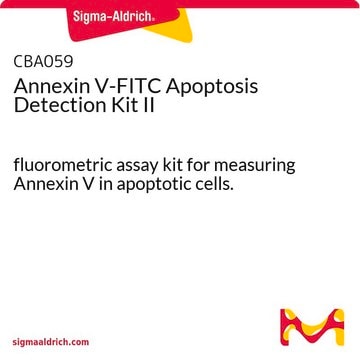APOBRDU
Flow Cytometry Kit for Apoptosis
About This Item
Productos recomendados
usage
sufficient for 60 cell suspensions
packaging
pkg of 1 kit
technique(s)
flow cytometry: suitable
application(s)
cell analysis
detection
detection method
fluorometric
shipped in
wet ice
storage temp.
2-8°C
Application
Features and Benefits
Packaging
Principle
Solo componentes del kit
- Br-dUTP 480 μL
- Fluorescein PRB-1 antibody 300 μL
- Negative control cells 5 mL
- PI/RNase staining buffer 30 mL
- Positive control cells 5 mL
- Reaction buffer .6 mL
- Rinsing buffer 120 mL
- Terminal deoxynucleotidyl transferase (TdT) 45 μL
- Wash buffer 120 mL
signalword
Danger
hcodes
Hazard Classifications
Carc. 1B - Eye Irrit. 2 - Flam. Liq. 2 - Resp. Sens. 1 - Skin Sens. 1
Storage Class
3 - Flammable liquids
flash_point_f
55.4 °F
flash_point_c
13 °C
Certificados de análisis (COA)
Busque Certificados de análisis (COA) introduciendo el número de lote del producto. Los números de lote se encuentran en la etiqueta del producto después de las palabras «Lot» o «Batch»
¿Ya tiene este producto?
Encuentre la documentación para los productos que ha comprado recientemente en la Biblioteca de documentos.
Los clientes también vieron
Artículos
Cell based assays for cell proliferation (BrdU, MTT, WST1), cell viability and cytotoxicity experiments for applications in cancer, neuroscience and stem cell research.
Nuestro equipo de científicos tiene experiencia en todas las áreas de investigación: Ciencias de la vida, Ciencia de los materiales, Síntesis química, Cromatografía, Analítica y muchas otras.
Póngase en contacto con el Servicio técnico










